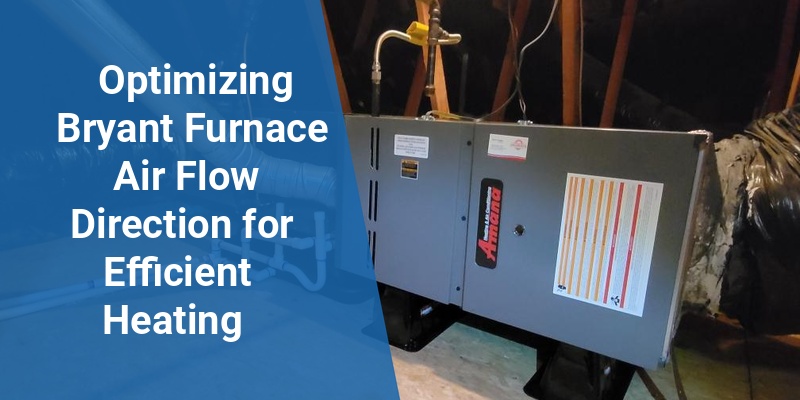Proper air flow direction in Bryant furnaces is critical for maximizing heating efficiency and ensuring safe operation. Understanding how air moves through the furnace allows homeowners and HVAC professionals to troubleshoot issues, improve indoor air quality, and maintain system longevity. This article explores the principles behind Bryant furnace air flow direction, key components influencing it, and practical tips for optimization.
| Aspect | Description |
|---|---|
| Air Intake | Where air enters the furnace for combustion and circulation |
| Blower Function | Circulates heated air through ductwork to living spaces |
| Exhaust Flow | Directs combustion gases safely outside |
| Air Filters | Clean incoming air to protect furnace and improve air quality |
How Air Flow Direction Works in a Bryant Furnace
In a Bryant furnace, air flow direction follows a precise path for efficient operation. Indoor air is drawn through return ducts and passes through the furnace filter to remove dust and particles. This cleaned air then moves into the furnace’s heat exchanger, where it is warmed by combustion heat.
The furnace’s blower motor pushes the heated air into the supply ducts, delivering warmth evenly throughout the home. Meanwhile, combustion byproducts are vented through specialized exhaust flues to ensure safety and compliance with HVAC standards.
Components Influencing Air Flow Direction
Several key components in Bryant furnaces determine how air flows and circulates:
- Return Air Ducts: Channels air from living spaces back to the furnace.
- Air Filters: Positioned before the blower to clean incoming air, affecting airflow resistance.
- Heat Exchanger: Transfers heat from combustion gases to circulating air.
- Blower Fan: Forces warm air into the home’s supply ducts.
- Exhaust Flue: Directs harmful combustion gases safely outside.
Correct Installation and Impact on Air Flow Direction
Proper installation of the Bryant furnace ensures that airflow is streamlined. Incorrectly sized or positioned ducts cause uneven temperature distribution and reduced efficiency.
Airflow direction should maintain a smooth, unobstructed path from return ducts through filters, across the heat exchanger, and out via supply ducts.
Misalignments or poorly sealed duct joints can lead to air leaks, reducing furnace performance and increasing energy costs.
Call 888-906-9139 for Free Local HVAC Quotes – No Obligation, Just Savings!
Common Air Flow Problems and Troubleshooting
Homeowners may experience some common problems linked to faulty air flow direction:
- Weak Heat Output: Often caused by dirty filters or blocked air returns restricting airflow.
- Uneven Heating: Poor duct design or obstructions interrupting proper air distribution.
- Loud Blower Noises: Indicate airflow restrictions or blower motor strain.
- Excessive Dust: Suggests faulty air filtration or leaks letting untreated air into the system.
Regular maintenance, including filter replacement and duct inspection, is essential to maintain proper airflow direction and furnace efficiency.
Optimizing Bryant Furnace Performance Through Air Flow Management
To enhance performance, some practical tips include:
- Use High-Quality Filters: Maintaining clean filters reduces resistance and improves airflow.
- Seal and Insulate Ductwork: Prevent air leaks that lower system efficiency.
- Ensure Proper Duct Sizing: Match duct sizes to furnace capacity to balance airflow.
- Maintain Blower Motor: Regular servicing ensures optimal operation of the air moving components.
- Schedule Annual HVAC Tune-Ups: Professional inspections help identify and address airflow issues early.
Energy Efficiency and Air Flow Direction
Proper air flow direction in Bryant furnaces directly impacts energy consumption and heating cost savings. Balanced airflow allows the furnace to heat the home uniformly without excessive workload, reducing wear and energy waste.
Additionally, well-managed airflow supports better humidity control and indoor air quality, increasing overall comfort.
How Bryant Furnace Models Differ in Air Flow Design
Different Bryant furnace models may vary slightly in airflow mechanics due to design or size:
| Model Type | Air Flow Characteristic |
|---|---|
| Single-Stage Furnaces | Operate at fixed airflow rates, simpler air flow path |
| Two-Stage Furnaces | Adjust airflow speeds for precise heating and comfort |
| Modulating Furnaces | Continuously vary airflow to maintain consistent temperature |
Understanding model-specific air flow can guide proper installation and maintenance strategies.
Call 888-906-9139 for Free Local HVAC Quotes – No Obligation, Just Savings!
Impact of Air Flow Direction on Indoor Air Quality
Efficient air flow management improves indoor air quality by ensuring that:
- Dust and allergens are filtered before air circulation.
- Combustion gases are correctly vented out.
- Moisture levels are controlled to prevent mold growth.
Regular filter changes and duct cleanings are vital to sustain a healthy environment.
When to Consult a Professional for Air Flow Issues
If there are persistent heating inconsistencies, unusual noises, or elevated energy bills, it’s advisable to seek HVAC professional assistance. Certified technicians can perform airflow diagnostics, duct sealing, and system calibrations tailored to Bryant furnaces. This ensures optimal air flow direction and system longevity.
